Contents of this Web Site
This web site contains a permanent collection of great art work. Also, we will be adding special exhibits so please check back periodically.
Admission
- Adults $10
- Children $5
- Seniors $6
- Students $7
Museum Location
The Museum is located in New York, NY on West 61st Street between 7th and 8th Avenue.
Museum Hours
- Mon - Fri 8AM - 9PM
- Saturday 9AM - 7PM
- Sunday 10AM - 7PM
Museum Mission Statement
It is the mission of this museum to provide the general public with the means to view and appreciate some of the greatetst works of art in the world. We at the museum want to share our love of art with anyone who is willing. Please browse our museum and feel free to leave your opinions so that we can continue to evaluate and update our exhibits and give you the highest quality museum that we can give.

Wednesday, February 21, 2007
The Special Collection of unknown, local artists.
Please feel free to post your opinions of the museum's Special Collection of unknown, local artists.
Friday, February 16, 2007
The Special Collection of Italian Renaissance painters.
Please feel free to post your opinions of the museum's Special Collection of Italian Renaissance painters.
Wednesday, February 14, 2007
The Special Collection of Willaim Blake
Please feel free to post your opinions of the museum's Special Collection of Willaim Blake.
Wednesday, January 31, 2007
The Permanent Collection
Please feel free to post your opinions of the museum's Permanent Collection.
Subscribe to:
Posts (Atom)
Permanent Collection
Curator's Statement of The Permanent Collection
The Permanent Collection of this museum contains works of the greatest painters the world has ever seen. We have Impressionism, Surrealism and Renaissance art. We are especailly proud of our large Renaissance collection containing Titian, Michelangelo and Raffaello Sanzio. Also, our Impressionist collection consists of some of the finest artists to come out of the Euopean Impressionist period. We also have Romantic Period and Surealist art. Please take your time in our museum and I hope you appreciate the art.
Romantic Period
William Blake (1757 -1827) was influential in the beginning of the romantic period. This powerful depiction of Blake's wrathful, law-giving character Urizen is perhaps his best-known image. Its composition draws on medieval representations of God creating the universe using the tools of an architect. Here, the snowy-haired figure kneels down from the sphere of Heaven and attempts to circumscribe the infinity of creation with a golden compass. The plate, designed as the frontispiece to the prophetic book Europe, was also issued as a separate print that later acquired the traditional but inaccurate title The Ancient of Days. It recalls Blake's pithy epigram:
To God—If you have formed a Circle to go intoGo into it yourself & see how you would do.
William Blake, Europe a Prophecy
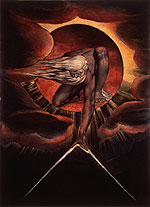
Watercolor and gouache on paper; 9 1/4 x 6 5/8 in., 1824
European Impressionists
Vincent Van Gogh, Starry Night
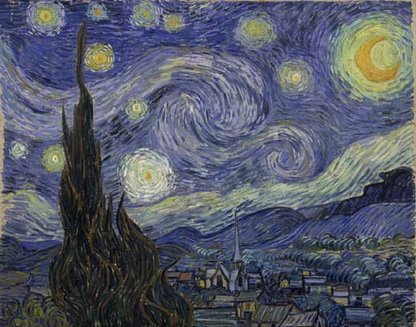
Oil on Canvas, 73.0 x 92.0 cm, 1889
Claude Monet, Water Lilies
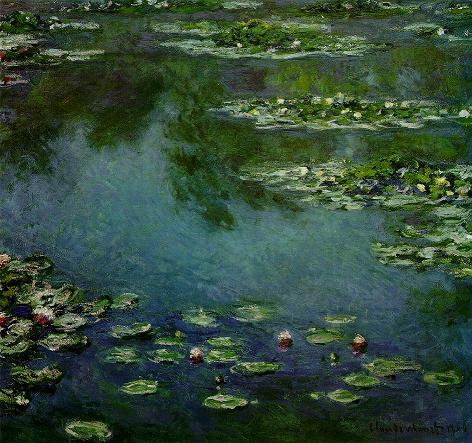
Oil on Canvas, 87.6 x 92.7 cm, 1906
Henri de Toulouse-Lautrec, At the Moulin Rouge: Two Women Waltzing
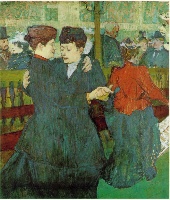
Oil on Cardboard, 93 x 80 cm, 1892
Pierre-Auguste Renoir, A Girl With a Watering Can
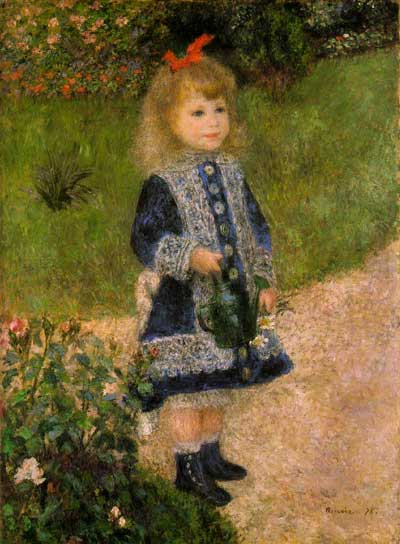
Oil on canvas, 100 x 73 cm, 1876
Paul Gauguin, Tahitian Women (On the Beach)
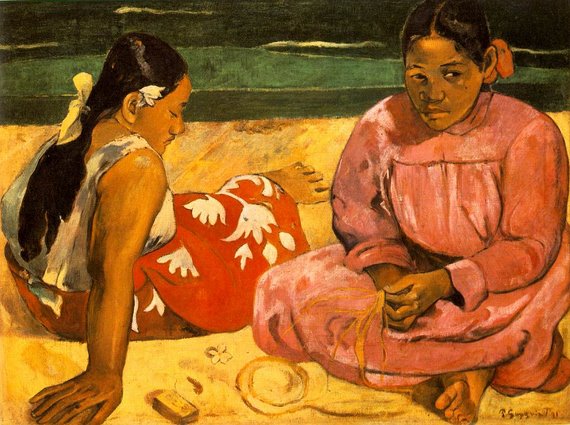
Oil on canvas, 69 x 91 cm, 1891
European Surrealists
Salatore Dali, The Persistence of Memory
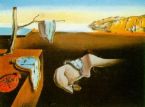
Oil on Canvas, 24 X 33 cm, 1931
Renaissance Artists
Titian (Tiziano Vecellio) was a Renaissance artist born in Italy who studied with artists of the time from the time he was a child. His largest influence was a painter by the name of Giogione so much so that some paintings by these two artists remain a mystery to this day as to which artist painted certain paintings. This is a collection of frescos from Titian’s first major assignment in 1511. This led to many more independent projects for Titian.
Titian, The Miracle of the Newborn Child
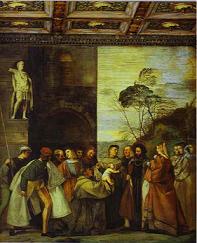
Fresco, 1511
Titian, The Healing of the Wrathful Son
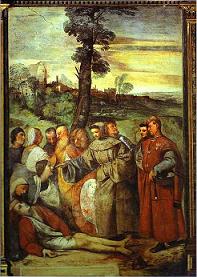
Fresco, 1511
Titian, The Miracle of the Jealous Husband
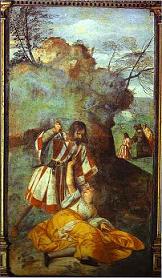
Fresco, 1511
Titian, Assumption of the Virgin
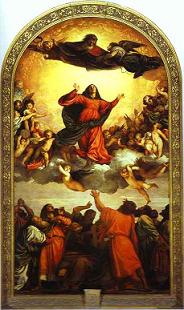
This painting is separate from the previous collection, but this is the piece that made Titian the most famous artist of his time in Venice. He was commissioned to paint for the Franciscan church of Santa Maria Gloriosa dei Frari in Venice. This painting was for the high altar.
Titian, Self Protrait
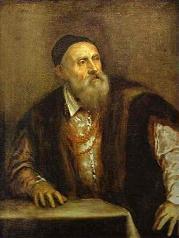
Oil on canvas, (1550-1562) .
Michelangelo di Lodovico Buonarroti Simoni was born in 1475 in Caprese in the Republic of Florence, Italy. He was an Italian Renaissance sculptor, painter, and architect.
Michelangelo, The Holy Family with the infant St. John the Baptist (the Doni Tondo)
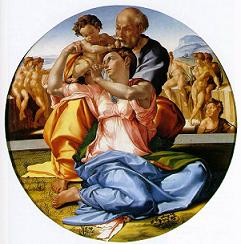
Tempera on Panel, 120 cm X 120 cm, 1503
Michelangelo, The Creation of Man
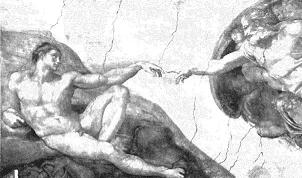
From the ceiling of the Sistine Chapel, 1511
Raffaello Sanzio was born in 1483 in Urbino, Duchy of Urbino, Italy. He was a painter and an architect during the Renaissance. He is known for Madonnas.
Raffaello Sanzio, Madonna dell Granduca
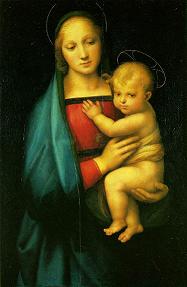
Oil on Wood, 84 x 55 cm, 1505
Raffaello Sanzio, The Nymph Galatea
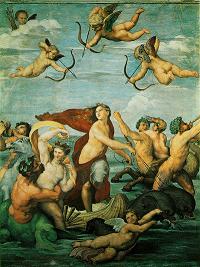
Fresco, 295 x 225 cm, 1512
Raffaello Sanzio, The Small Cowper Madonna

Oil on wood, 59.5 x 44 cm, 1505
!!
Special Collection I: William Blake
Curator's Statement of Special Collection
This Special Collection features William Blake. We chose Blake as a special collection due to the narrative qualities of his paintings. Blake was an expert at illustrating scenes from books and poems in his work. He was a painter and a writer and told stories in his writings as well as his paintings.
William Blake (1757 -1827) was influential in the beginning of the romantic period. He did not believe in any form of hierarchy therefore he never received any money for his artwork. His philosophy was to conserve nature for future generations to enjoy as much as past generations. People are bound up in the world and should let nature show us how everything is holy and equally important. Knowledge is a matter of perspective and experience, and we should question what society expects of us and to not blindly accept what is not working. Blake believed that humanity has a purpose to make the world a better place and without a purpose we fear death. Death is not a termination but a transformation.
William Blake, The Book of Urizen: The Web of Religion

Watercolor and ink on paper, 11 3/8 x 9 1/4", 1794
William Blake, The Ancient of Days

Relief etching with watercolor, 23.3 x 16.8 cm,1794
William Blake, The Body of Abel Found by Adam and Eve
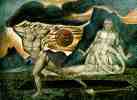
Watercolor on wood, 32 x 43 cm, 1825
William Blake, Capaneus the Blasphemer
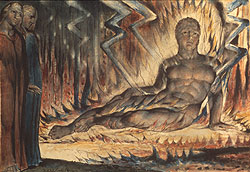
Pen and black ink on paper, 37.3 X 52.7cm, 1825
William Blake, Beatrice addressing Dante from the car
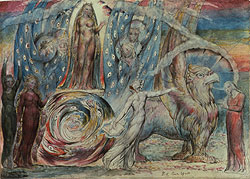
Pen, Black Ink and Watercolor on Paper, 37.2 X 52.7cm, 1827
William Blake, Oberon Titania and Puck with Fairies
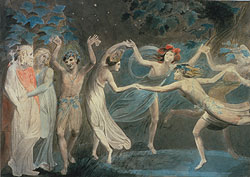
Water Color over Graphite on Paper, 47.5 X 67.5cm, 1785
William Blake, The Angel Gabriel appearing to Zacharias

Pen and black ink, tempera, 36.7 X 38.1cm
Songs of Innocence and of Experience, 1794/ca.1825
Blake originally produced this small, richly illustrated collection of short lyrics as two separate books: Songs of Innocence (1789) and Songs of Experience (1794). He combined them into a single volume in 1794. Although the Songs' compact, simple, and colorful format recalls a children's book, the themes within are sophisticated and complex. Innocence and Experience contrast opposite states of human existence, before and after the Fall. The pastoral poems in Innocence express religious faith and acceptance and exhibit fine, flowing lines; the bardic verses in Experience, by contrast, convey disillusionment and anger and employ bolder contours.
Blake produced only twenty-four copies of the combined volume; this is one of the last, prepared about 1825 for the painter and printmaker Edward Calvert. Its deep, saturated hues and distinctive ornamental borders (found on only one other copy) contrast with the lighter, paler colors of editions printed three decades earlier. The book remained in Calvert's family until the late 19th century and in 1917 became the first work purchased for the Metropolitan Museum's new Department of Prints by its distinguished first curator, William M. Ivins Jr.
Songs of Innocence and of Experience
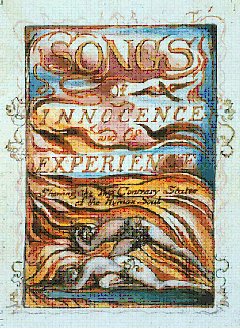
Relief etchings printed in orange-brown ink, heightened with watercolor and shell gold, with hand-painted decorative borders; 6 1/8 x 5 1/2 in. (15.7 x 14.1 cm)
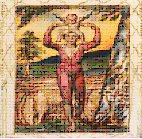



Angel of the Revelation
Revelation 10:1-7
"Then I saw another mighty angel coming down from heaven. He was robed in a cloud, with a rainbow above his head; his face was like the sun, and his legs were like fiery pillars. He was holding a little scroll, which lay open in his hand. He planted his right foot on the sea and his left foot on the land, and he gave a loud shout like the roar of a lion. When he shouted, the voices of the seven thunders spoke. And when the seven thunders spoke, I was about to write; but I heard a voice from heaven say, "Seal up what the seven thunders have said and do not write it down." Then the angel I had seen standing on the sea and on the land raised his right hand to heaven. And he swore by him who lives for ever and ever, who created the heavens and all that is in them, the earth and all that is in it, and the sea and all that is in it, and said, "There will be no more delay! But in the days when the seventh angel is about to sound his trumpet, the mystery of God will be accomplished, just as he announced to his servants the prophets."
Description:
Blake does not illustrate the biblical text, but its miraculous origin. From his vantage point with the naturalistic foreground space, the diminutive figure of Saint John observes the divine vision that he will later record, embodied in the towering figure of the angel, perhaps inspired by the ancient statue of the Colossus at Rhodes. Indicating the source of his divine text with his heavenward glance and upraised arm, the angel points to the vision that unfolds about his person: above his fiery legs, seven horsemen, presumably embodying the seven thunders of the biblical text, charge through the clouds at the base of his cloak. The subtle coloring, stippled watercolor technique, and extensive pencil underdrawing indicate a date toward the middle of the series.
Angel of the Revelation
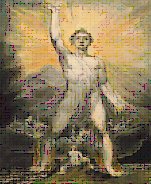
Watercolor, pen and black ink, over traces of graphite, 39.2 x 26 cm, 1803
Pity
The existence of a unique proof print (British Museum), in which Blake experimented with his technique on a small scale, suggests that Pity was the first large color print produced by the artist. The child and rider illustrate a double simile from Shakespeare's Macbeth (1:7), in which Macbeth considers the pitiable reaction to his murder of Duncan in terms of vulnerability and vengeance, the human and the supernatural: Macbeth 1.7: 21–25
"And Pity, like a naked new-born babe,Striding the blast, or heaven's cherubin hors'dUpon the sightless couriers of the air,Shall blow the horrid deed in every eye,That tears shall drown the wind."
Pity
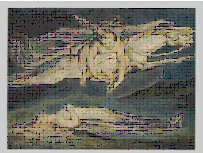
Color print finished with pen and ink and watercolor on paper, second impression, 42.1 x 52.8 cm, 1795
King Sebert, the North Front of his Monument
While apprenticed to the engraver James Basire, Blake prepared an exquisite series of watercolors depicting monuments in Westminster Abbey. Blake's designs served as the basis for engravings used to illustrate various publications of the Society of Antiquaries. (Although the sheets are undoubtedly Blake's work, Basire's signature, as master of the shop, appears on them.) The elegant, serene, and elongated medieval figures would have a profound impact on Blake's mature artistic style. Here, he presents a monument, newly discovered in 1775, of the 7th-century East Anglian king believed to have founded Westminster Abbey
King Sebert, the North Front of his Monument
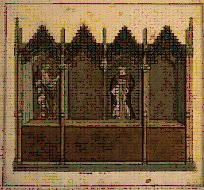
Watercolor, pen and black ink, and shell gold over traces of graphite on paper, 39 x 28.9 cm, 1775
!!
Special Collection II: Local Unknown Artists
Curator's Statment of Special Collection
This Specail Collection is designed to showcase local, unknown artists. We have displayed a some self portraits as well as other art from our featured artists.
Dean Pomykala
Dean Pomykala , Self Portrait
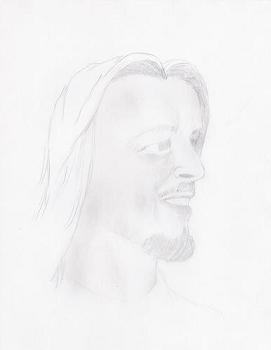
Pencil on Paper, 8 1/2 x 11 in., 2007
Dean Pomykala , Self Portrait (Impressionist)
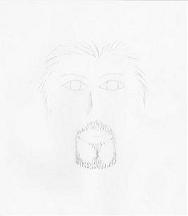
Charcoal on Paper, 8 1/2 x 11 in., 2007
Dean Pomykala , Blinded by Science
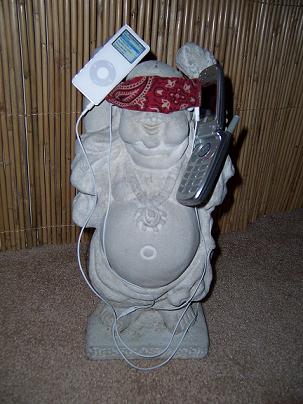
Random Items, 14 Inches Tall x 6 Inches Wide, 2007
Dean Pomykala , Stir Fry

Food, 8 1/2 x 11 in., 2007
Bill Mellinger
Bill Mellinger, Self Protrait (Catch me Today)
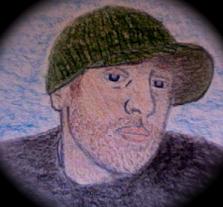
Colored Pencil on Paper, 2007
Bill Mellinger, Self Portrait (Still Rising)
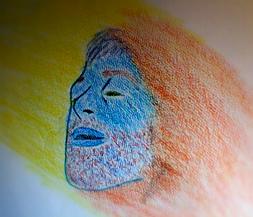
Colored Pencil on Paper, 2007
Bill Mellinger, Inverted Sketch
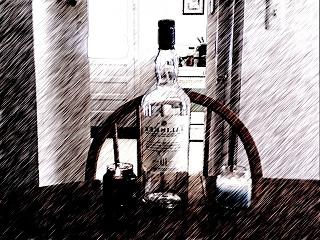
Digital, 2007
Bill Mellinger, Thermal Illumination
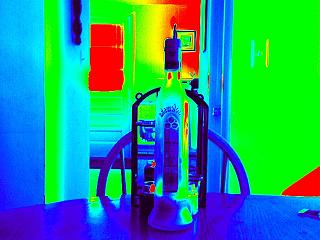
Digital, 2007
Starla Jordan
Starla Jordan, Self Pottriat

Pencil on Paper, 2007
Starla Jordan, Self Portrait

Pencil on Paper, 2007
Starla Jordan

Digital, 2007
Starla Jordan

Digital, 2007
Rosemary Lerner
Rosemary Lerner, Self Portrait
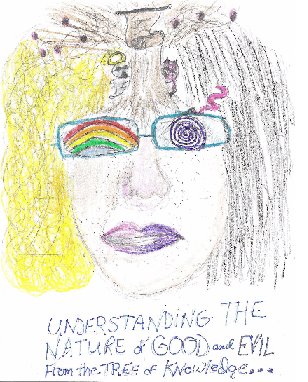
Colored Pencil on Paper, 8 1/2 x 11 in., 2007
Rosemary Lerner, Self Portrait

Colored Pencil on Paper, 8 1/2 x 11 in., 2007
Rosemary Lerner, Obscure Joy
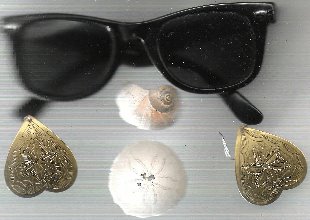
Digital, 2007
Rosemary Lerner, Pleasure Treasure
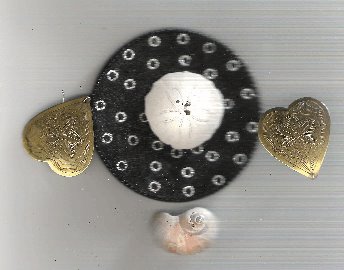
Digital, 2007
Rosemary Lerner, Dark Delusion
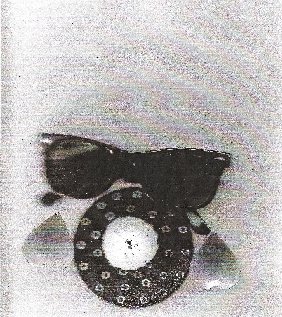
Digital, 2007
Special Collection III: Italian Renaissance Painters
Curator's Statement of Special Collection
This Special Exhibit is based on the Italian painters of the The Renaissance Period of the late 15th century through the 17th century. We have featured artists such as Leonardo da Vinci and Botticelli. However, take a look at all of these works of art because they all have represent the Italian Renaissance movement.
RENAISSANCE PERIOD
During this period, Italy—and in the fifteenth century, Florence above all—is the seat of an artistic, humanistic, technological, and scientific flowering known as the Renaissance. Founded primarily on the rediscovery of classical texts and artifacts, Renaissance culture looks to heroic ideals from antiquity and promotes the study of the liberal arts, centering largely upon the individual's intellectual potential. As a result, tremendous innovations are made in the fields of mathematics, medicine, engineering, architecture, and the visual arts, while a surge of vernacular literature attempts not only to emulate, but also to surpass antique models. Some of the most celebrated figures of Renaissance Italy, supremely exemplified by the artist, scientist, and inventor Leonardo da Vinci (1452–1519), excel in several fields.
FLORENCE AND CENTRAL ITALY
At this time, Florence is a hub of humanist scholarship and artistic production, due largely to the funding of the powerful Medici family, who, by the end of the period, exert their political and financial influence over much of central Italy. Significant urban development also occurs in Siena, an important artistic center, and the influential Montefeltro rulers of Urbino establish an illustrious court at which the liberal and visual arts flourish.
Giovanni di Ser Giovanni (called Lo Scheggia), The Triumph of Fame
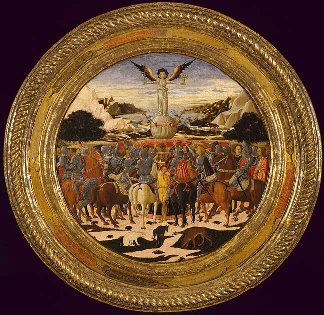
Tempera, silver, and gold on wood, 92.7 X 92.7cm, 1449
The Triumph of Fame; Impresa of the Medici Family and Arms of the Medici and Tornabuoni Families
This is an object of unique historical importance. It was kept by Lorenzo in his private quarters in the Medici palace in Florence and was acquired in the early years of the nineteenth century by Alexis-François Artaud de Montor, one of the earliest collectors of early Italian painting. Later it belonged to Thomas Jefferson Bryan, the first New Yorker to collect early Italian art.
Raphael, Madonna and Child Enthroned with Saints
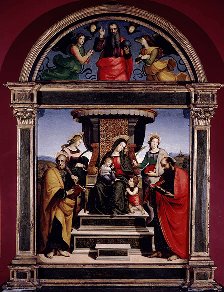
Tempera and gold on wood, 67 7/8 x 67 7/8 in., 1504
Madonna and Child Enthroned with Saints, altarpiece, ca. 1504
This important early altarpiece by Raphael was painted for the small Franciscan convent of Sant'Antonio in Perugia and hung in a part of the church reserved for nuns. According to Vasari, it was the nuns who asked Raphael to depict the Christ Child and infant Saint John the Baptist fully clothed. Their patronage may also account for the painting's conservative style and the emphasis given to gold decoration.
The Last Communion of Saint Jerome
The subject of this picture is taken from a text on Jerome's death written by the church historian Eusebius. The saint is shown in his bedroom cell near Bethlehem, supported by his brethren. The picture, which dates from the early 1490s, was painted for the Florentine wool merchant Francesco del Pugliese, who described it in his will of 1502. A supporter of Savonarola, Pugliese may have been attracted to the subject for its deeply devotional content. The exceptionally fine frame on this picture was carved in the workshop of Giuliano da Maiano. Its painted lunette is by Bartolomeo di Giovanni, who not only collaborated with Botticelli on at least one occasion but copied this picture as well.
Bronzino, Portrait of a Young Man
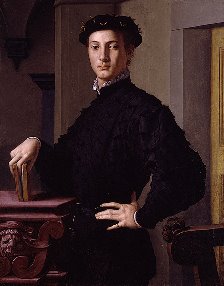
Oil on wood, 37 5/8 x 29 1/2 in., 1530's
Portrait of a Young Man
This portrait—among Bronzino's most arresting—was painted in the 1530s. The sitter is not known, but he must have belonged to Bronzino's close circle of literary friends, which included the historian Benedetto Varchi and the poet Laura Battiferri, both of whom sat for the artist. Bronzino himself composed verses in the style of Petrarch, and some of the fanciful and witty conceits in this picture—the grotesque heads on the table and chair and the masklike face formed by the youth's breeches—would have been much appreciated in literary circles.
Lorenzo Monaco, Coronation of the Virgin
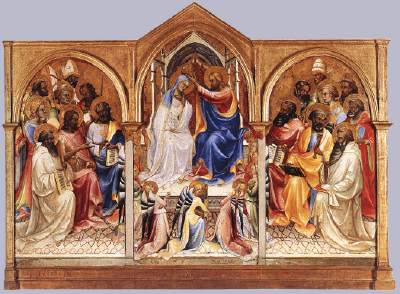
Egg tempera on poplar, 182 x 105 cm, 1414
Lorenzo Monaco, The Nativity
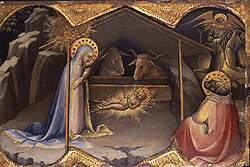
Tempera on wood, gold ground; 8 3/4 x 12 1/4 in., 1409
Benozzo Gozzoli, Meeting at the Golden Gate
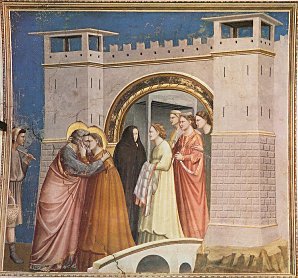
1491
Fillippino Lippi, Vision of St. Bernard
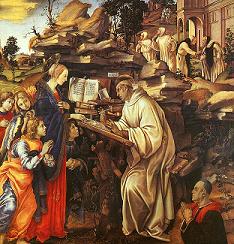
1485
Andrea Del Castagno, Vision of St. Jerome
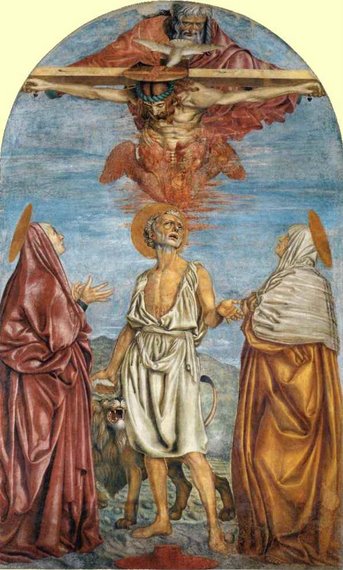
Fresco, 1454
Leonardo da Vinci
Leonardo da Vinci was an Italian painter, draftsman, sculptor, architect, and engineer whose genius epitomized the Renaissance humanist ideal. The Last Supper (1495-97) and Mona Lisa (1503-06) are among his most widely popular and influential paintings.
Leonardo da Vinci, Portrait of Mona Lisa

Oil on wood, 77 x 53 cm, 1503-06
Mona Lisa
This figure of a woman is dressed in the Florentine fashion of her day and seated in a mountainous landscape. It is an example of Leonardo's sfumato technique of soft, heavily shaded modeling. The Mona Lisa's enigmatic smile has given the portrait universal fame.
Leonardo da Vinci, The Last Supper
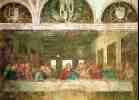
Fresco, 460 x 880 cm, 1498
Leonardo da Vinci, Ginevra de' Benci

Oil on wood, 38.2 x 36.7 cm, 1474
Sandro Botticelli
Botticelli (1445 - 1510, Florence). An early Florentine Renaissance painter whose Birth of Venus (c. 1485) and Primavera (1477-78) are often said to epitomize spirit of the Renaissance. His works include art for all the major churches of Florence and for the Sistine Chapel in Rome.
Botticelli, The Birth of Venus
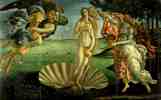
Tempera on canvas, 172.5 x 278.5 cm, 1485-86
Botticelli, La Primavera
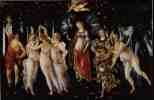
315 x 205 cm, 1477-78
Botticelli, Madonna of the Magnificat
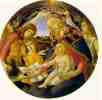
Tempera on Panel, 118 cm X 118 cm, 1485
Botticelli, The Last Communion of Saint Jerome
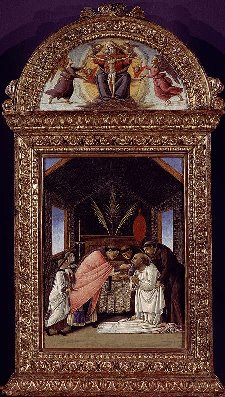
Tempera and gold on wood, 13 1/2 x 10 in., early 1490's